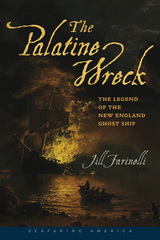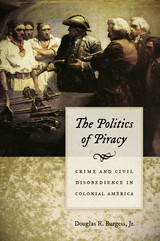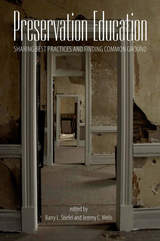247 scholarly books by University Press of New England and 12
start with P
247 scholarly books by University Press of New England and 12
247 scholarly books by University Press of New England
12 start with P start with P
12 start with P start with P

The Palatine Wreck
The Legend of the New England Ghost Ship
Jill Farinelli
University Press of New England, 2017
Two days after Christmas in 1738, a British merchant ship traveling from Rotterdam to Philadelphia grounded in a blizzard on the northern tip of Block Island, twelve miles off the Rhode Island coast. The ship carried emigrants from the Palatinate and its neighboring territories in what is now southwest Germany. The 105 passengers and crew on board—sick, frozen, and starving—were all that remained of the 340 men, women, and children who had left their homeland the previous spring. They now found themselves castaways, on the verge of death, and at the mercy of a community of strangers whose language they did not speak. Shortly after the wreck, rumors began to circulate that the passengers had been mistreated by the ship’s crew and by some of the islanders. The stories persisted, transforming over time as stories do and, in less than a hundred years, two terrifying versions of the event had emerged. In one account, the crew murdered the captain, extorted money from the passengers by prolonging the voyage and withholding food, then abandoned ship. In the other, the islanders lured the ship ashore with a false signal light, then murdered and robbed all on board. Some claimed the ship was set ablaze to hide evidence of these crimes, their stories fueled by reports of a fiery ghost ship first seen drifting in Block Island Sound on the one-year anniversary of the wreck. These tales became known as the legend of the Palatine, the name given to the ship in later years, when its original name had been long forgotten. The flaming apparition was nicknamed the Palatine Light. The eerie phenomenon has been witnessed by hundreds of people over the centuries, and numerous scientific theories have been offered as to its origin. Its continued reappearances, along with the attention of some of nineteenth-century America’s most notable writers—among them Richard Henry Dana Sr., John Greenleaf Whittier, Edward Everett Hale, and Thomas Wentworth Higginson—has helped keep the legend alive. This despite evidence that the vessel, whose actual name was the Princess Augusta, was never abandoned, lured ashore, or destroyed by fire. So how did the rumors begin? What really happened to the Princess Augusta and the passengers she carried on her final, fatal voyage? Through years of painstaking research, Jill Farinelli reconstructs the origins of one of New England’s most chilling maritime mysteries.
[more]

Parks and People
Managing Outdoor Recreation at Acadia National Park
Edited by Robert E. Manning
University Press of New England, 2009
Parks and People describes fifteen years of research at Maine’s Acadia National Park, conducted by Robert E. Manning, his colleagues, and students. The book is organized into three parts. Part I addresses indicators and standards of quality for park resources and the visitor experience. Part II describes efforts to monitor indicator variables. Part III outlines and assesses management actions designed to maintain standards of quality. The book concludes with a discussion of the implications of this program of natural and social science research, including a series of principles for outdoor recreation management at Acadia and other parks.
[more]

Peak Experiences
Danger, Death, and Daring in the Mountains of the Northeast
Edited by Carol Stone White
University Press of New England, 2012
In the mountains, the difference between a pleasant day of hiking and a life-threatening disaster is as simple as a loose rock, a turned ankle, or a misjudged patch of ice. In an instant, even the most experienced and prepared of outdoorspersons can find themselves at the mercy of the elements (and their own choices) — and suddenly, sometimes tragically, the situation slips out their control. In this collection of over fifty tales of day hikes and long treks gone awry, the seasoned climber and writer Carol Stone White brings together some of her favorite tales of outdoor misadventure written by colleagues and fellow enthusiasts who have experienced the harsher side of climbing the peaks of New England and the Adirondacks. From freak falls to outrunning storms, from life-threatening hypothermia to the excitement of unlikely rescues, these tales inform as much as they entertain, teaching even the experienced climber that accidents can happen to anyone and that preparation and the ability to make split-second decisions can often mean the difference between life and death. Like sitting around the campfire sharing tales of terror and near death with your hiking buddies, this collection will appeal to the true outdoorsperson as well as the armchair adventurer.
[more]

The Philosophy of Franz Rosenzweig
Edited by Paul Mendes-Flohr
University Press of New England, 2002
Eleven essays on the life and thought of the Jewish philosopher and theologian Franz Rosenzweig.
[more]

Picasso and the Chess Player
Pablo Picasso, Marcel Duchamp, and the Battle for the Soul of Modern Art
Larry Witham
University Press of New England, 2013
In the fateful year of 1913, events in New York and Paris launched a great public rivalry between the two most consequential artists of the twentieth century, Pablo Picasso and Marcel Duchamp. The New York Armory Show art exhibition unveiled Duchamp’s Nude Descending a Staircase, a “sensation of sensations” that prompted Americans to declare Duchamp the leader of cubism, the voice of modern art. In Paris, however, the cubist revolution was reaching its peak around Picasso. In retrospect, these events form a crossroads in art history, a moment when two young bohemians adopted entirely opposite views of the artist, giving birth to the two opposing agendas that would shape all of modern art. Today, the museum-going public views Pablo Picasso as the greatest figure in modern art. Over his long lifetime, Picasso pioneered several new styles as the last great painter in the Western tradition. In the rarefied world of artists, critics, and collectors, however, the most influential artist of the last century was not Picasso, but Marcel Duchamp: chess player, prankster, and a forefather of idea-driven dada, surrealism, and pop art. Picasso and the Chess Player is the story of how Picasso and Duchamp came to define the epochal debate between modern and conceptual art—a drama that features a who’s who of twentieth-century art and culture, including Henri Matisse, Gertrude Stein, André Breton, Salvador Dalí, and Andy Warhol. In telling the story, Larry Witham weaves two great art biographies into one tumultuous century.
[more]

A Plague on All Our Houses
Medical Intrigue, Hollywood, and the Discovery of AIDS
Bruce J. Hillman
University Press of New England, 2016
A frightening new plague. A medical mystery. A pioneering immunologist. In A Plague on All Our Houses, Dr. Bruce J. Hillman dissects the war of egos, money, academic power, and Hollywood clout that advanced AIDS research even as it compromised the career of the scientist who discovered the disease. At the beginning of the worldwide epidemic soon to be known as AIDS, Dr. Michael Gottlieb was a young immunologist new to the faculty of UCLA Medical Center. In 1981 he was brought in to consult on a battery of unusual cases: four formerly healthy gay men presenting with persistent fever, weight loss, and highly unusual infections. Other physicians around the country had noted similar clusters of symptoms, but it was Gottlieb who first realized that these patients had a new and deadly disease. He also identified the defect in their immune system that allowed the disease to flourish. He published his findings in a now-iconic lead article in the New England Journal of Medicine—an impressive achievement for such a young scientist—and quickly became the focal point of a whirlwind of panic, envy, desperation, and distrust that played out against a glittering Hollywood backdrop. Courted by the media, the gay community, and the entertainment industry, Gottlieb emerged as the medical face of the terrifying new epidemic when he became personal physician to Rock Hudson, the first celebrity AIDS patient. With Elizabeth Taylor he cofounded the charitable foundation amfAR, which advanced public awareness of AIDS and raised vast sums for research, even as it struggled against political resistance that began with the Reagan administration and trickled down through sedimentary layers of bureaucracy. Far from supporting him, the UCLA medical establishment reacted with dismay to Gottlieb’s early work on AIDS, believing it would tarnish the reputation of the Medical Center. Denied promotion and tenure in 1987, Gottlieb left UCLA for private practice just as the National Institutes of Health awarded the institution a $10 million grant for work he had pioneered there. In the thirty-five years since the discovery of AIDS, research, prevention, and clinical care have advanced to the point that the disease is no longer the death sentence it once was. Gottlieb’s seminal article is now regarded by the New England Journal of Medicine as one of the most significant publications of its two-hundred-year history. A Plague on All Our Houses offers a ringside seat to one of the most important medical discoveries and controversies of our time.
[more]

The Politics of Piracy
Crime and Civil Disobedience in Colonial America
Douglas R. Burgess
University Press of New England, 2014
The seventeenth-century war on piracy is remembered as a triumph for the English state and her Atlantic colonies. Yet it was piracy and illicit trade that drove a wedge between them, imperiling the American enterprise and bringing the colonies to the verge of rebellion. In The Politics of Piracy, competing criminalities become a lens to examine England’s legal relationship with America. In contrast to the rough, unlettered stereotypes associated with them, pirates and illicit traders moved easily in colonial society, attaining respectability and even political office. The goods they provided became a cornerstone of colonial trade, transforming port cities from barren outposts into rich and extravagant capitals. This transformation reached the political sphere as well, as colonial governors furnished local mariners with privateering commissions, presided over prize courts that validated stolen wares, and fiercely defended their prerogatives as vice-admirals. By the end of the century, the social and political structures erected in the colonies to protect illicit trade came to represent a new and potent force: nothing less than an independent American legal system. Tensions between Crown and colonies presage, and may predestine, the ultimate dissolution of their relationship in 1776. Exhaustively researched and rich with anecdotes about the pirates and their pursuers, The Politics of Piracy will be a fascinating read for scholars, enthusiasts, and anyone with an interest in the wild and tumultuous world of the Atlantic buccaneers.
[more]

Pond and Brook
A Guide to Nature in Freshwater Environments
Michael J. Caduto
University Press of New England, 1990
Designed specifically for the amateur naturalist and filled with hands-on projects and activities, Pond and Brook introduces the readers to the intriguing world of freshwater life. Michael Caduto’s keen eye investigates all common freshwater environments, from wetlands and deep lakes to streams and vernal ponds. An important feature of the book is its holistic approach to both living and non-living components of freshwater environments, and how they fit together to weave an ecological whole. Readers will learn the unique properties of water, the basic principles vital to understanding aquatic life, and the origin of freshwater habitats.
[more]

Porches of North America
Thomas Durant Visser
University Press of New England, 2012
The porch, whether simple or grand, evokes feelings of welcome, comfort, and nostalgia in all of us, yet there has been little published on the history of this omnipresent architectural feature. This book examines how porches in their many forms have evolved in the United States and Canada through innovations, adaptations, and revivals. Covering formal porches and verandas, as well as the many informal vernacular types, this book proffers insights into broad cultural customs and patterns, as well as regional preferences and usage. Lavishly illustrated with contemporary and historic photographs, Porches of North America provides a chronological and typological framework for identifying historic porches. All those who love to while away afternoons on a favorite porch will find this architectural history delightful as well as informative.
[more]

Preservation Education
Sharing Best Practices and Finding Common Ground
Edited by Barry L. Stiefel and Jeremy C. Wells
University Press of New England, 2014
Over the past twenty years, there has been a fundamental shift in the institutional organization of historic preservation education. Historic preservation is the most recent arrival in the collection of built environment disciplines and therefore lacks the pedagogical depth and breadth found in allied endeavors such as architecture and planning. As the first degree programs in preservation only date to the 1970s and the first doctoral programs to the 1990s, new faculty are confronted with pedagogical challenges that are unique to this relatively nascent field. Based on a conference that included educators from around the world, Barry L. Stiefel and Jeremy C. Wells now present a collection that seeks to address fundamental issues of preservation pedagogy, outcome-based education and assessment, and global issues of authenticity and significance in historic preservation. The editors argue that the subject of the analysis has shifted from, “What is the best way to fix a historic building?” to, “What are the best ways for teaching people how to preserve historic properties (and why) according to the various standards that have been established?” This important reconsideration of the state of the field in historic preservation education will appeal to a broad audience across numerous disciplines.
[more]

The Puritan Experiment
New England Society from Bradford to Edwards
Francis J. Bremer
University Press of New England, 1995
This revised and updated edition of an out-of-print classic once again makes the broad background of Puritanism accessible to students and general readers. Based on a chronology that begins with the Act of Supremacy in 1534 and ends with Jonathan Edwards's death in 1758, Francis J. Bremer's interpretive synthesis of the causes and contexts of the Puritan movement integrates analyses of the religious, political, sociological, economic, and cultural changes wrought by the movement in both Old and New England. From meeting house architecture to Salem witch trials, from relations with Native Americans to the founding of the nation's first colleges, he details with style and grace "a living system of faith" that not only had profound significance for tens of thousands of Englishmen and Americans in the sixteenth and seventeenth centuries, but also affected the course of history in the New World.
[more]

The Puritan Tradition in America, 1620–1730
Edited by Alden T. Vaughan
University Press of New England, 1997
Many students of our national character would agree that, for better or worse, the Puritan tradition had an enormous effect on the assumptions and aspirations of today's Americans. This book tells the story, largely through the participants' own words, of the emergence of that tradition. It provides a broad range of primary documents--religious, political, social, legal, familial, and economic--for an understanding of Puritanism in early New England. Originally published in 1972, it is reissued here with a new introduction and two new documents: extracts from Anne Hutchinson's trial and from John Winthrop's "Experiencia".
[more]
READERS
Browse our collection.
PUBLISHERS
See BiblioVault's publisher services.
STUDENT SERVICES
Files for college accessibility offices.
UChicago Accessibility Resources
home | accessibility | search | about | contact us
BiblioVault ® 2001 - 2024
The University of Chicago Press









